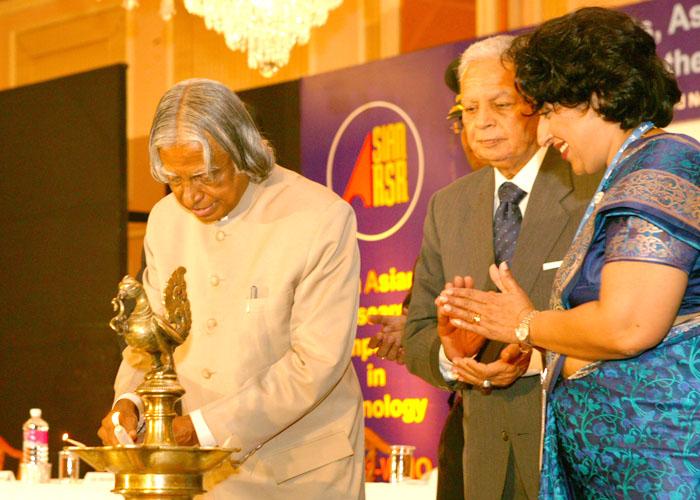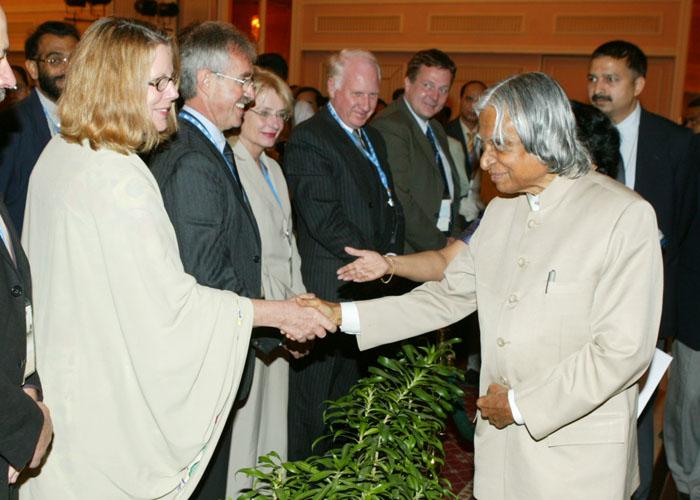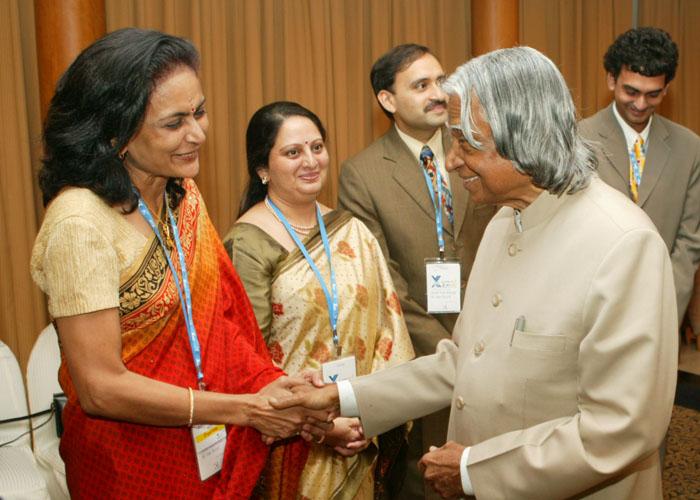Address At The Inauguration Of 9th Asian Research Symposium In Rhinology & 10th Biennial Congress Of The Trans-pacific Allergy & Immunology Society
Mumbai : 18-11-2004
Impact of Genetic Research in Rhinology and Immunology
I am delighted to be with the specialists in the field of Rhinology & Immunology and to participate in the inauguration of the 9th Asian Research Symposium in Rhinology & 10th Biennial Congress of the Trans-Pacific Allergy & Immunology Society. I greet the organizers, Rhinologists, Immunologists, pediatrician?s medical technologists, pharmacologists, academicians, national and international experts and distinguished guests, who have assembled here to deliberate on the theme ?Rhinitis, Sinusitis and Asthma in the 21st century?.
Universal access to medical care
Friends, when I am in the midst of experts in the field of Rhinology and allergic diseases, I am reminded of the famous statement by Norman Cousins in his book, ?Anatomy of the illness?, ?Patients are today reaching out to the doctor not just for medical help. They are reaching out for kindness, assurance and hope.? I would also like to share with you a quote in the Paper which I came across on the topic, ?One World, One people, One surgery? by Dr.T.E. Udwadia which states: ? The poorest of the poor have as much right as anyone to less pain after surgery, reduced medication, less morbidity, shorter hospitalization, and early return to home, family, and work. Minimal access surgery and the expensive technology it requires are advocated, not as homage or tribute to new technology, but in appreciation of the manifold benefits this new technology gives our patients and our people.? This thought has to be the focus of the specialists in Rhinology and allergic diseases.
Status of allergic diseases
The incidence of respiratory diseases, especially those of the nose like rhinitis and sinusitis, research in this field as well as treatment strategies - both medical and surgical - are fast advancing. The Asian region comprises nearly half of the world?s population and therefore results nearly half of the world?s global burden of diseases. Moreover, the Asian region maintains much diversity in geography, race, lifestyle and dietary habits, which can influence the characteristics, prevalence and treatment patterns of diseases. I feel we should make use of this diversity and different health care systems to find a standardized diagnostic method and implementation of standard treatment guidelines leading to optimal patient care and better quality of life for the people in this region. The available clinical data of various countries can become one of the important data-bases for research. Among the medical community in Asian countries there should be connectivity for mutual sharing of clinical data. This aspect of ?clinical data generation in Rhinology? should be discussed in this international conference.
At the turn of the 19th century, allergic diseases were rare, but their increasing incidence, affecting from 10 to 50% of the population, is well recognized in the developed as well as developing countries. World Allergy Organization (WAO) data shows 40% of the world?s population is a topic, and in fact in India 25-26% of the population suffer from some form of allergic diseases and more than 50% of these suffer from Allergic rhinitis. I understand that approximately 10 ? 20% of children in India suffer from asthma and 80% of these children are allergic.
Impact of environment
This rapid increase in allergic diseases and asthma appears to be related to changes in lifestyle, increased exposure to allergen, increased environmental pollution due to tobacco smoke, ozone, nitric oxides, sulphur dioxide, diesel exhaust etc., and altered dietary habits. Many people who live with this disease even do not know what allergy they suffer from. Awareness about asthma and other allergic diseases, appropriate counseling, removing myths regarding these diseases and right treatment are the important tasks that need to be undertaken on a massive scale.
Treatment of allergic diseases
In the treatment of both rhinitis and asthma treating the underlying inflammation is crucial along with relief of symptoms. I understand drugs like inhaled or intranasal steroids are crucial to controlling the inflammation and disease progression. These drugs have been proved to be safe and usage of appropriate controlled medication would prevent long term economic costs and morbidity. One should think of both immediate as well as long term implications of the treatment regime. The definition of recovery in these allergic diseases varies. Can we call the temporary relief as cure? This needs to be discussed in the Symposium. I am sure the results of this Conference will be useful to various components of the society including medical practitioners and researchers.
Research areas
Recently, I was in Chennai at Dr. Cherian?s Medical Centre. It is known as, International Centre for Biomedical Sciences and Technology (Research & Applications). There I interacted with Dr. Emmanuel, who is working in the area of Gene Chip. He says the Gene Chip can be used for finding the existence of genetic diseases including coronary artery diseases or neuro defect in the baby during a certain stage of pregnancy itself. The chip could also be modified to suggest to the patient?s system to develop those chemicals which in turn will help the patient recover from the present situation. The specialists assembled here must debate whether gene chip can be used for identifying the susceptibility of the baby to the allergic diseases in the advanced stage of pregnancy. This may enable finding a treatment regime for the mother which may give immunity to the child from the allergic disease. In the ?New Scientist? dated 6th November 2004, it is reported that the developing human embryos have a gap in the same place in the upper jaw which later fuses. If it fails to fuse, the result is a cleft palate or cleft lip. Most likely, then these birth defects would arise from the same development process that gave us the ability to breath through our noses. It is reported with proof in animal test, lifetime exposure to certain toxins (Rotenone) will lead to Parkinson?s Disease. I suggest, both these findings can be studied by the Rhinologists for possible regimes of remedy.
It is reported that gene differences between humans and most animals are very nominal. More than 90% of our DNA is similar. This property is a boon to researchers since animal models can be subsequently used for curing human diseases based on trial data. I would recommend the medical researchers to progress further in this area for finding the application of Gene Chip as a diagnostic tool and as a treatment regime for allergic diseases and asthma.
Recently I launched an integrated software package called Bio-suite jointly developed by a Consortium of TCS, academic and the Council of Scientific and Industrial Research (CSIR). Bio-Suite is the state-of-the-art software package that caters to all aspects of computational biology from genomics to structure-based drug design. The successful development of Bio-suite highlights our understanding of biology as a self-sustaining dynamic equilibrium. Today, we are able to look objectively at the intricacies of living organisms. The next step forward would be to understand the controlling of it involving clinical research. Endocrine system imbalances and autoimmune disorders will be interesting areas. Every cell or organ in a body is totally dependent on the rest of body. We should be working fast to integrate therapeutic processing into Bio-suite. Rhinologists can further go into details of the research potential of Bio-suite in the fields of rhinology and immunology.
Alternate system of medicine
Many Yoga practitioners claim that human system is basically self reliant and has the ability to find cure for all the diseases occurring within our body through the breathing system. The suggestion is practicing of regulated breathing exercise accompanied by a healthy vegetarian food habit and lifestyle. In this connection many countries in Asia, particularly China, India, Korea etc, have traditional medicines for allergic disorders. This Congress, I am sure, will take steps to collate the database and establish the possible cure and immunology elements, in collaboration with traditional medical centres of the native country. This can definitely become a complimentary cost effective system of medicine.
Networking the rhinology resources
I am glad to know that you are going to launch a website that will become the common platform amongst the Rhinologists and Immunologists and provide the connectivity for the thousand specialists from 30 countries who have gathered here for this Congress. The website can document the case studies and special treatment regimes followed by different specialists and also the novel diagnostic techniques used by them. You could also include provision for the common man to ask questions about his specific problems connected with allergic diseases which can be answered by a panel of specialist doctors. This will also lead to automatic generation of a database of such patients and make treatment of these diseases available by specialists at an affordable cost. However, the confidentiality and anonymity of the patient has to be maintained by the website. This website can be used for creating awareness regarding asthma and other allergic diseases, their appropriate treatment and removing uncertainties regarding these diseases.
Conclusion
Medical profession is a noble profession and it has always been patient centric. The patient has the right to have right type of medical care, with right type of medical practitioners. How does a patient know, whether he should go to an ENT specialist, or an allergy specialist or a chest specialist? He is made to go from one place to another in search of the right specialists. An integrated mechanism is needed to see that patient without frustration is directed to the right specialist for right diagnosis at the right time at a right cost. Medical community, particularly the physicians, may discuss these aspects from the patient?s point of view in this Symposium.
The human respiratory system is the life line for the healthy functioning of the entire body. In this domain of yours, you may collaborate with the other specialists and experts in the field of cardiology, neurology, nephrology, vascular diseases etc. to find a total solution with minimum intervention and bring a smile in the patients.
I wish you all success for the 9th Asian Research Symposium in Rhinology and 10th Biennial Congress of the Trans-Pacific Allergy & Immunology Society for providing allergy free life to the mankind.
May God bless you.




